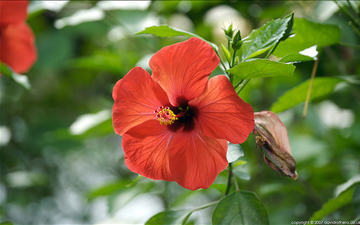Hibiscus rosa-sinensis, known colloquially as the Chinese hibiscus, China rose and shoe flower, is an evergreen flowering shrub native to East Asia.
It is widely grown as an ornamental plant throughout the tropics and subtropics. The flowers are large, generally red in the original varieties, and firm, but generally lack any scent. Numerous varieties, cultivars, and hybrids are available, with flower colors ranging from white through yellow and orange to scarlet and shades of pink, with both single and double sets of petals. Despite their size and red hues attractive to nectar-feeding birds, they are not visited regularly by hummingbirds when grown in the Neotropics. Generalists, like the Sapphire-spangled Emerald, Amazilia lactea, or long-billed species, like the Stripe-breasted Starthroat, Heliomaster squamosus, are occasionally seen to visit it, however.[1] In the subtropical and temperate Americas, hummingbirds are attracted to them on a regular basis.
Hibiscus flower preparations are used for hair care. The flowers themselves are edible and are used in salads in the Pacific Islands. The flowers are used to shine shoes in parts of India. It is also used for the worship of Devi and especially the red variety takes an important part in tantra. In Indonesia, these flowers are called “kembang sepatu”, which literally means “shoe flower”.
Hibiscus rosa-sinensis is considered to have a number of medical uses in Chinese herbology.[2]
(From Wikipedia, May 17th, 2010)





